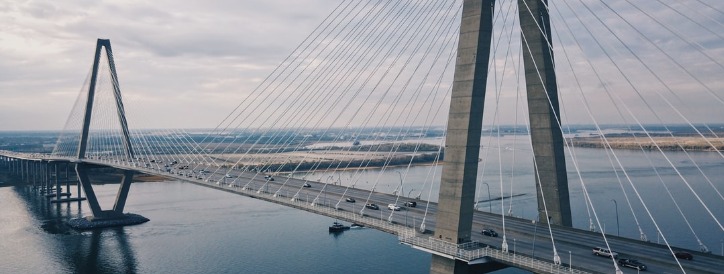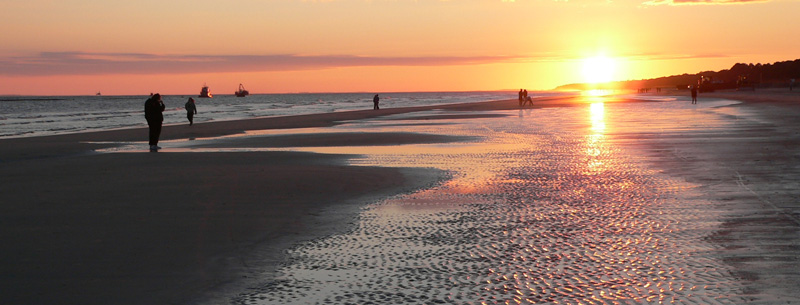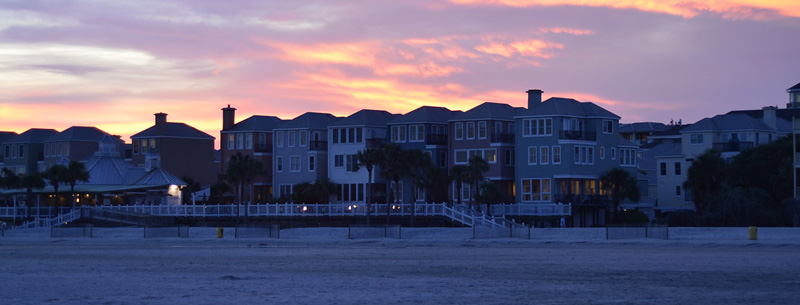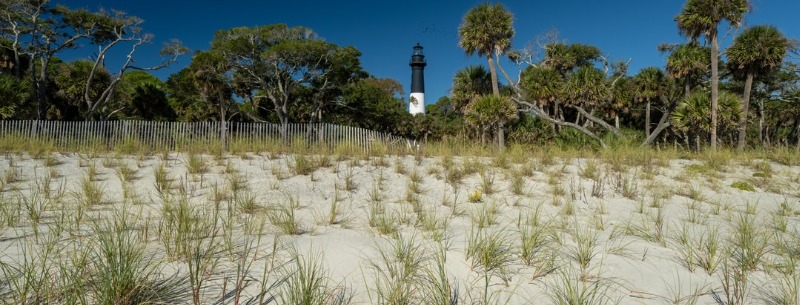Best South Carolina Beaches for the Family
The relatively small state of South Carolina remains, with Mississippi, one of the poorest and most rural pockets of the US, although the prime real estate along its coast has lately been developed into exclusive golf courses and tennis clubs.
South Carolina’s fascinating subtropical coastline of sea islands, great beaches, marshes and lush palmetto groves preserves traces of a virtually independent black culture (featuring the unique patois gullah), from the days when slaves escaped the mainland plantations.
Beyond the grand old peninsular port of Charleston, arguably the most elegant city in the US with its rainbow-colored old buildings and magnificent, tree-lined avenues, restored plantations stretch as far north as Georgetown, en route toward the poseur’s paradise of Myrtle Beach.
No matter if you’re looking for a secluded island retreat or a rollicking, fun-filled vacation, South Carolina will provide the perfect beach or island resort for you.
South Carolina beaches:
Charleston
Charleston, one of the finest-looking cities in the US, today spreads way beyond its original confines on the tip of a peninsula at the confluence of the Ashley and Cooper rivers, roughly one hundred miles south of Myrtle Beach and north of Savannah, Georgia.
It’s a compelling place to visit, its historic district lined with tall, narrow houses of peeling, multicolored stucco, adorned with wooden shutters and ironwork balconies wrought by slaves from Barbados.
The Caribbean feel is augmented by palm trees, a tropical climate and easygoing atmosphere, while the town’s pretty hidden gardens and leafy patios evoke New Orleans.
Despite the crowds, however, it has kept its atmosphere, while maintaining all the energy and life of a real, working town.
The gullah traditions of the sea islands are a tangible presence here, too: “basket ladies” weave their sweetgrass baskets all around the market and near the post office, and many people – black and white – speak the distinctive gullah dialect.
The river road, Hwy-61, leads west from Charleston along the Ashley River, past a series of magnificent plantations. Many can be visited, although in best Southern tradition, house tours tend to dwell on the furniture and dining habits of the slave masters rather than provide a sense of social history.
Drayton Hall, closest to Charleston at 3380 Ashley River Rd., is a particularly fine Georgian mansion, looking much as it did in the mid-eighteenth century with its handcarved wood and plasterwork.
The nearby Magnolia Plantation and Gardens, ten miles from downtown Charleston, is most notable for its stunning ornamental gardens, particularly in spring when the azaleas are blooming.
East of Charleston, beaches such as Isle of Palms and Sullivan’s Island are heavily used by locals at weekends. The further you get from town, the more likely you are to find a stretch to yourself.
Edisto Island
South of Charleston toward Savannah, the coastline dissolves into small, marshy islands.
Edisto Island, south of US-17 on Hwy-174, is typical: huge live oaks festooned with great drapes of Spanish moss line the roads, beside bright green marshes with rich birdlife, and great beaches on the seaward side.

Believed to have been inhabited 4,000 years ago by Edistow Indians, Edisto Island is one of the oldest settlements in South Carolina.
You’ll find traces of the early inhabitants today, with a shell mound on the beach that is believed to have been used as a burial ground or ceremonial site. In 1674, the Earl of Shaftesbury purchased the island from the Indians, and a land grant was issued to Paul Grimball. You can see the ruins of his plantation along the North Edisto River.
If you want to stay, there are no budget motels, but the campground at Edisto Beach State Park is near a great beach lined with palmetto trees and other semitropical plants.
Edisto Beach State Park was originally developed in the 1930’s by the Civilian Conservation Corps. A variety of shells dot the 1.5 mile beach and some of the tallest palmetto trees in the state can be seen throughout the park.
This 1,255-acre park includes a dense maritime forest and an expansive salt marsh where visitors can explore the wonders of nature.
The park offers a day-use area for beach access and a four-mile nature trail that winds through the maritime forest with beautiful vistas overlooking the salt marsh.
Fripp Island
Just 19 miles east of Beaufort, the resort offers guests controlled access to the island, three and one-half miles of beach, three championship golf courses, tennis courts, and posh accommodations.
Fripp Island resort is a first-class, oceanfront resort, boasting some of the world’s finest amenities.
Enjoy the beautiful South Carolina coast on more than 3 miles of pristine beach, find the latest fashions at several shops and boutiques or test your skill on Davis Love III’s signature Ocean Creek Golf Course or the Ocean Point course designed by George Cobb.
If you’re looking for a little more action Fripp has it. Biking, kayaking, boating, fishing and many other family activities are at your fingertips.
Wind down and relax after a day of fun with drinks and dinner as you watch the sun go down at one of Fripp’s restaurants.
A new seaside waterpark, features a children’s pool with alligator slides and giant frog fountain.
Park your car once you arrive. The favorite mode of transportation on Fripp Island is a golf cart, which is rented by the day or week.
Hilton Head Island
Discovered by English sea captain William Hilton in 1663, Hilton Head Island boasts some of the most luxurious accommodations in the county.
The development of Hilton Head began in the 1950s, when Charles Fraser developed Sea Pines Plantation. He worked diligently to attract visitors as well as permanent residents to the island, providing golf courses, bike paths, marinas, and other amenities while preseving the island’s natural setting.

The largest sea island between New Jersey and Florida, Hilton Head covers 42 square miles of broad beaches, nine marinas, over two dozen championship golf courses, and more tennis courts than any other resort of its size.
The four main resorts communities of Palmetto Dunes, Port Royal Resort, Sea Pines Plantation, and Shipyard Plantation offer a wide variety of accommodations, including villas, houses, inn, and oceanfront hotels.
While in Hilton Head, you may wish to explore the Indian shell ring at Sea Pines Forest Preserve. One of the only 20 known to exist, the ring is believed to have been built around the same time as the great pyramids.
Scientists believe that it was intended as a refuse heap, with oysters, clams, and mussel shells, as well as the bones of deer, raccoons, bear, and fish. The ring is approximately 150 feet in diameter and several feet deep, and is listed on the National Register of Historic Places.
Explore more than four miles of beach, maritime forests and salt marshes. Observe white-tailed deer and more than 125 species of birds. Fish for whiting, spot, bass, and drum.
Campsites and cabins are within easy walking distance to the ocean.
Isle of Palms
In 1898, visitors to Isle of Palms came by way of water or a single railroad bridge.
Originally opened as a recreational area for privileged parties at beach homes, this semi-tropical retreat, bordered by beautiful beaches and a network of marsh creeks, has lost none of its original charm.

On the tip of Isle of Palms, a barrier island off South Carolina, Wild Dunes Resort is a 1,600-acre oceanfront paradise 20 minutes from the charm and grace of historic Charleston.
The resort offers world-renowned golf, top 10 ranked tennis, nation’s top 5 ranked recreation program, extensive meeting facilities for groups up to 800, and over two miles of pristine beach.
Four restaurants and 2 lounges complement the resort.
At the heart of the resort, the Four Star, Four Diamond Boardwalk Inn offers 93 guest rooms, luxurious suites and 3 unique function rooms. In addition, there are 350 villas and luxurious homes.
Myrtle Beach
Birthplace of Wheel of Fortune star Vanna White, Myrtle Beach is a brazen splurge of seaside fun, an unmitigated stretch of commercial development twenty miles down the coast from the North Carolina border at the center of the sixty-mile “Grand Strand.”
Predominantly a family resort, it’s packed fit to burst during mid-term vacations with leering, jeering students in fluorescent beachwear – if you’ve seen the movie Shag, you’ll know what to expect.

Fans of crazy golf, water parks, factory outlet malls, funfairs and parasailing will be in heaven, and the beach itself isn’t bad.
The widest stretch is at North Myrtle Beach, a chain of small communities among which Ocean Drive is the center and Atlantic Beach is exclusively used by African Americans.
Today the area has become known, not only for its spectacular beaches, but as one of the leading golf destinations in the world. The Grand Strand boasts over 90 golf courses, many of which were designed by such masters as: Robert Trent Jones, Tom Fazio, Arnold Palmer, Jack Nicklaus, the Dyes, Dan Maples and Rees Jones to name a few.
With its mild climate, natural “low country” beauty, state-of-the-art medical facilities and overall laid back quality of life, the Myrtle Beach area is popular for those seeking a second home or retirement spot.
South of Myrtle Beach lie Murells Inlet, a fishing port with lots of good fish restaurants, and Pawleys Island, a secluded resort once favored by plantation-owners and today retaining a far slower pace than its neighbors.
St. Helena Island
Across the bridge to the southeast of Beaufort, St. Helena Island is among the least spoiled of the eastern sea islands.
The landscape is gorgeous: amazing Spanish moss and enormous, wide views out across bright marshes, and small shrimp and oyster fishing communities. Occasionally you see what looks like a fleet of ships in the middle of a field, only to realize that in fact the boats are anchored in a small salt creek, hidden by bright green marsh reeds.
This is an area of strong black communities, descended from slaves, who were given parcels of land when they were freed by the Union army in February 1865 and who speak a dialect known as gullah, an Afro-English patois with many West African words.
Set back from the road is a museum containing fascinating old pictures of black fishermen and farmers, plus old tools and shrimp nets, and rattlesnake skins.
Nearby, off US-21, the ruined black Chapel of Ease, nestled among the thick Spanish moss, with seashell-adorned interior walls, makes for an interesting visit if you have a half-hour to spare.
Before the bridge across to Hunting Island is the Shrimp Shack, an excellent fresh seafood joint, where the “shrimp burger” has to be seen to be believed, and should ideally be eaten at one of the trestle tables overlooking the shrimp boats bobbing in the marshy shallows.
St. Helena’s main beach, nine miles beyond the museum at Hunting Island State Park on the east shore, can get crowded, but it’s simply idyllic: soft white sand, wide and gently shelving, scattered with shards of pearly shells and lined with palmettos, palm trees and sea oats.
The water is incredibly warm. Pelicans come in to feed, particularly in the early morning, and the shrimp fleet sails past soon after.
You can stay near the beach in weather-beaten cabins backing onto a glassy lagoon full of jumping fat fish, although you need to reserve from a year and a half to two years in advance.
